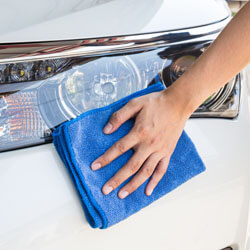
Now that winter has finally released its grip, it's time to make sure your vehicle is ready for the road ahead with the following spring car cleaning and maintenance tips.
Spring car cleaning tips
- Grab a garbage bag and remove all the junk that has amassed over the winter. Look under the seats, go through all the pockets, and don't forget the glove compartment too.
- Vacuum the upholstery and the floor. Don't forget to move the seats to get at those hard-to-reach areas.
- Scrub the floor mats to get rid of any salt and dirt build-up brought in from the slush and snow.
- Clean the dash and console with a damp soft cloth to get rid of dust.
- Clean the windows and buff the glass with a microfibre cloth to minimize streaks.
- Pop open the trunk and throw out any garbage. Take the vacuum to your trunk as well.
- If you have a car safety kit, don't put it in storage. Most people think they only need it during the winter, but you really should keep it in your car for the whole year. You never know when you might need that flashlight or those jumper cables.
- Don't forget the exterior! Wash your car in a shaded area, starting with the roof and working your way down. Use mild diluted soap and dry your vehicle right away to prevent water spots.
Spring clean your auto insurance
- Just like your car, your car insurance needs attention too. Compare auto insurance quotes today to ensure you are getting the best price for your coverage. On average, drivers save 20 percent (about $346) after shopping for a better rate and you could too.
Spring car maintenance tips
In addition to a good spring cleaning, make sure your car is up to the task of getting you where you need to go safely after a season of harsh winter conditions. Some of the following tips will require a mechanic, while others may only need you to follow the instructions in your owner's manual.
- Change your wiper blades. They should be replaced every six months.
- Check your vehicle's various lights-both inside and outside of the car-to make sure they're all working, and replace if necessary.
- Swap out your winter tires. Winter tires can't take the heat. They'll wear out faster and won't provide you with the same handling capabilities as all-season or summer tires.
- Check your tire pressure on a monthly basis. If your tire pressure is off, safety features like your antilock brakes may not function correctly, your vehicle's fuel efficiency will suffer, and your tires won't last as long as they should.
- While checking your tire pressure, look over the treads. According to BeTireSmart.ca, "All tires sold in Canada are manufactured with "wear bars." These coloured bars become exposed when there is less than 1.6 mm of tread depth remaining on your tire. Tires must be replaced when the wear bar is visible." They also suggest trying the "Bluenose" test where you place a Canadian dime in the tire's groove, with the Bluenose's sails pointing down. If you can see the top of the sails, then the tire needs to be replaced.
- A change of season equals a change of oil and filter. This will help to ensure your car operates at peak efficiency. And beyond oil, there are many other fluids that need to be checked including the transmission fluid, coolant, brake fluid, and power steering fluid.
- Inspect your windshield for chips and cracks. According to BeCarCareAware.ca "any damage to your windshield can decrease the overall effectiveness of airbags, seatbelts, roof stability, and your personal safety in the event of an accident. If your windshield has a crack, it's important to have it repaired or replaced immediately."
A mechanic is your car's best friend and it's generally recommended that you take your car in for an inspection every three months, or about every 5,000 to 6,000 kilometres driven. Your mechanic will look over more than what's listed here, including your car's battery, hoses, and belts-all components that can really take a beating over the winter. A springtime visit to your mechanic means that you may be able to fix minor maintenance issues, before they become a major headache.




